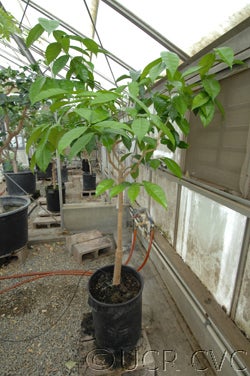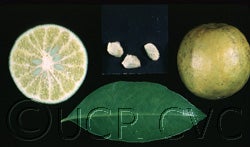Clymenia polyandra
CRC 3284
PI 263640
Source
Received as seed from Dr. Harold Winters, Beltsville, Maryland, 1960.
Parentage/origins
Parents unknown.
Rootstocks of accession
Own root.
Season of ripeness at Riverside
Has not been observed.
Notes and observations
EMN, 1986: This was field planted at CRC in 1983 and did not survive, probably is too tender for the field here and should be kept in the greenhouse only.
Description from The Citrus Industry Vol. 1 (1967)
"Tanaka's original description (in Latin) may be translated about as follows: "Branches triangular, glabrous, without spines; leaves oblong, caudate-acuminate, abruptly narrowed at the base, irregularly serrate; petioles very short, not articulated [with the leaf blade], and not winged, but furrowed [on the upper side]; flowers single in the axils of the leaves, with rather long, somewhat thick, pedicels; calyx saucer-shaped, obscurely toothed; stamens up to 100, free, arising in many rows outside the disk; filaments linear; anthers oblong; ovary ellipsoid; style thick, very short; stigma capitate, somewhat pentagonal; fruit oblong, somewhat lemon-shaped, with an inconspicuous mammilla at the tip; peel thin, segments numerous; pulp vesicular, yellow, rather sweet; pulp-vesicles short, blunt, very numerous; seeds obovoid, superposed."
The twigs are spineless and the leaves are very peculiar, being elliptical, acuminate at both ends, with the base merging into a very short, slender, wingless petiole which is not articulated or in any way marked off from the blade. The flowers are produced singly in the axils of the leaves, petals short and broad (7 X 7 mm); stamens very numerous (50-100) in many whorls, with short filaments (5 mm), pistils shorter than the stamens, ovary ovoid, with a broadly rounded tip not merging into the style, ovary with 14-16 locules, style short (only half as long as the ovary), with capitate stigma; fruit lemon-shaped, 4.5 X 6-7 cm, with a short nipple at the apex; pulp sweet; seeds numerous, superposed, polyembryonic.
Tanaka deserves the credit for having first noticed the great divergence of this plant in many of its essential taxonomic characters from any other of the known True Citrus Fruit Trees. However, he considered it to be a hybrid of Citrus macroptera and C. medica, which is said by Lauterbach to be "commonly planted at the [European ?] stations."
After studying Citrus macroptera and other members of the subgenus Papeda and observing the hybrids between them and species of the subgenus Citrus that are common in the Philippines, Swingle became convinced that a hybrid such as Tanaka thought his Citrus polyandra to be (Citrus macroptera X C. medica) could not possibly show a wingless petiole, even though one supposed parent, the citron, has an almost completely wingless petiole, because the other supposed parent, C. macroptera, has a very long, very broadly winged petiole (certainly the largest petiole to be found in Citrus).
The extraordinarily close resemblance of the leaves and petioles of this species to those of Monanthocitrus convinced Swingle that this plant was an entirely new type of citrus fruit tree, possibly having descended from a remote ancestral species common also to Monanthocitrus. Swingle thereupon published Clymenia as a new genus to include this plant.
This species, called a-mulis by the natives in the village of Namatanai in New Ireland, is cultivated for its sweet fruits."
Availability
Not commercially available in California.
USDA Germplasm Resources Information Network page for Clymenia polyandra

